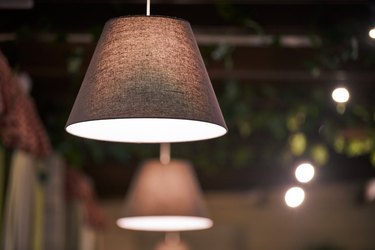
Before you swap one lampshade for another, it's a good idea to look at both shades and the assembly around a lamp's bulb to determine how the shade stays on the lamp. In other words, some lampshades have different fittings than others, so it's important to know the terms for lampshade parts to ensure you're getting the right type of shade for your lamp. Any type of lampshade covered in fabric has the same basic parts, although their styles may vary.
Lampshade Frame Forms the Shape
Video of the Day
The frame of the average lampshade is exactly what it sounds like: the metal framework that determines the size and shape of the complete shade. If you tore all the fabric off a lampshade, the frame and fitting would be the only remaining parts. Likewise, if you want to make your own lampshade, you have to build the frame to hold the other parts in place. The frame includes the horizontal metal pieces at the top and bottom, as well as the vertical parts that help the fabric stay in its intended shape on the lampshade.
Video of the Day
Lampshade Fabric Adds Style
The fabric on a lampshade is the material visible on the outside of the shade. According to Royal Lampshades, burlap is a common fabric choice, while linens and silky fabrics add a more refined sense of style. The outer fabric may be pleated on some shades. The outer fabric generally allows at least some light to flow through.
Many have additional decorative trim at the top and bottom of the shade, or at very least, trim in the same fabric type as the outer lampshade fabric. This trim helps hide seams and edges. Some trim also has beads or tassels for added detail.
The Lampshade Lining Affects the Light
The lining is the material used inside the lampshade; it's most commonly made of fabric, plastic or styrene. It hides the frame so it's not visible inside or outside the shade, but its main purpose is to determine how much light flows through the shade. The thicker the lining, the less light flows through shade in many cases. Most lampshades liners are fairly translucent, allowing light through so the shade itself glows a bit. Though not as common, some liners are opaque enough that most of the light from the lamp comes out the top and bottom of the shade, rather than through the shade.
Novelty or hidden-image lampshade liners have images or silhouettes on the inside, such as animal figures or even landscapes, that aren't visible on the outside of the lampshade when the light is off. Once the light is on, the images show through the shade. According to Mother Earth Living, it's easy to modify a white lampshade to show images by printing them on vellum and then adhering them to the liner with a glue stick.
The Fitter Matters Most
The fitter, or the fitting at the top of the shade, attaches the shade to the lamp. A spider fitter is the type that's most common, especially for table lamps. This type has a small ring in the center, which balances over the top of the lamp harp. The harp is the arched piece that goes around a lightbulb, similar to an arched doorway. The ring on the spider fitter sits on the flat spot of the harp, and then a finial, which is a decorative screw-in piece, goes in after the shade is in place. Turn it clockwise to tighten and hold the shade in place.
An uno fitter also has a ring in the center, but this design connects to the base of the lamp socket instead of to a lamp harp. You can tell the difference visually because the uno fitter isn't near the top of the lampshade. Uno fitters are most common on hanging lamps since they have no harp and the bulb sits upside down.
Even less common are clip-style fitters, which have teardrop-shaped metal pieces that slide over the actual lightbulb. The simplest ones have just two curved pieces that attach opposite one another on the bulb, while some have four pieces and are called double clips. Candelabra clips are made for candelabra bulbs, while round clips are made for any standard bulb shape.